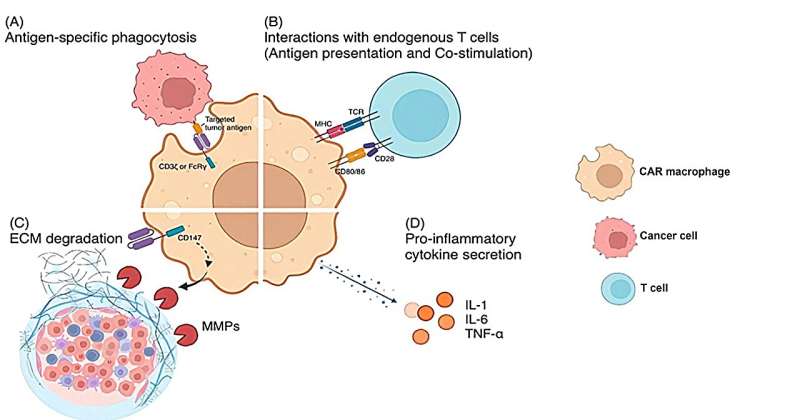This article has been reviewed according to Science X's editorial process and policies. Editors have highlighted the following attributes while ensuring the content's credibility:
fact-checked
trusted source
proofread
The front line of cancer warfare: CAR-T vs. CAR-macrophage therapies

In the exploration of cancer treatment modalities, an article published in Biomolecules and Biomedicine titled "CAR-macrophage versus CAR-T for solid tumors: The race between a rising star and a superstar," offers an examination of the evolving landscape in oncological therapeutics.
This scholarly review elucidates the mechanisms, challenges, and potential of chimeric antigen receptor (CAR) T therapy and CAR macrophage therapy, particularly in their application against solid tumors.
Central to the discussion is the innovative adaptation of macrophages in CAR macrophage therapy. This approach, distinct in its strategic advantage for targeting solid tumors, encompasses a multifaceted attack plan and enhanced penetrative ability into tumor cores. The review juxtaposes this with CAR T therapy, emphasizing their shared challenges, notably the elusive nature of suitable tumor cell targets.
This comparative analysis not only contrasts but also contemplates the potential synergy and mutual learning between these two modalities, reinforcing their collective efficacy against solid tumors.
The article further underscores the imperative for ongoing research, particularly in identifying novel therapeutic targets and conducting extensive clinical trials focused on solid tumors. These endeavors are crucial for advancing our understanding of the benefits and risks associated with both CAR-T and CAR macrophage therapies.
Additionally, the review delves into the structural and functional aspects of CAR in both therapies. The evolution of CAR-T cells through four generations, each marked by distinct cytoplasmic domains, is elaborated upon. Similarly, the diverse cytoplasmic signaling domains of CAR macrophages are explored, highlighting their role in mediating antigen-specific phagocytosis and in degrading the extracellular matrix surrounding solid tumors.
More information: Kun Chen et al, CAR-macrophage versus CAR-T for Solid Tumors: The Race between A Rising Star and A Superstar, Biomolecules and Biomedicine (2023). DOI: 10.17305/bb.2023.9675



















